Linarite is a mineral that belongs to the sulfate class and is characterized by its striking deep blue to azure color. It is named after the Linares district in Spain, where it was first discovered. Linarite is not only appreciated for its vibrant color but also has geological significance and is of interest to mineralogists, geologists, and collectors alike.
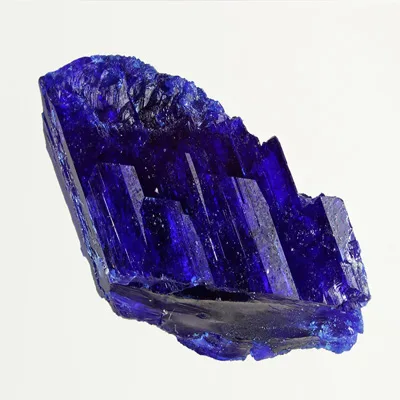
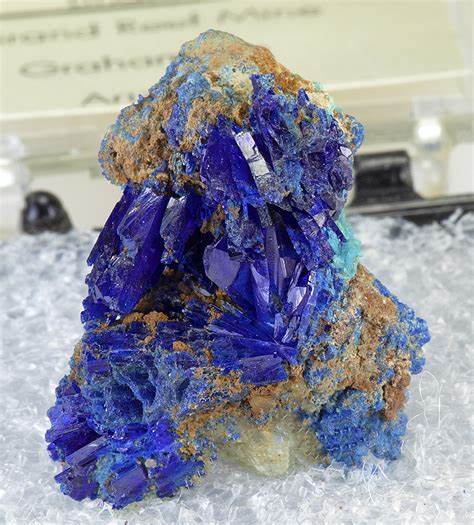
Definition: Linarite is a rare secondary mineral that typically forms as a result of the weathering of primary lead and copper ore deposits. It is a copper lead sulfate hydroxide mineral with the chemical formula CuPb(SO4)(OH)2. This mineral often occurs in association with other secondary minerals, including anglesite, cerussite, and azurite, in the oxidized zones of lead and copper ore deposits. Linarite is known for its beautiful blue crystals, which can be transparent to translucent, and its vivid coloration is highly prized by collectors.
Geological Significance: Linarite has several geological and mineralogical significance:
- Indicator of Ore Deposits: Linarite is commonly found in the oxidized zones of lead and copper ore deposits. Its presence can serve as an indicator to geologists that these metallic ores may be present in the vicinity. Understanding the mineralogical assemblage, including linarite, can help in mineral exploration and ore deposit modeling.
- Environmental Implications: The formation of linarite is often associated with the weathering and oxidation of primary ore minerals. This can have environmental implications, especially in mining regions, as the release of copper and lead into the environment can be a concern due to their potential toxicity. Monitoring and understanding the formation of linarite can be important for assessing environmental impact.
- Mineral Collecting: Linarite is highly valued by mineral collectors for its vibrant blue color and distinct crystal forms. Specimens of well-formed linarite crystals are sought after by collectors and can be found in mineral and gem shows around the world.
In summary, linarite is a visually striking mineral with a deep blue color, and its geological significance lies in its association with ore deposits and its role as an indicator mineral for certain metallic ores. Additionally, the formation of linarite and its presence in mining areas can have environmental implications, making it of interest to both geologists and environmental scientists.
Formation and Occurrence of Linarite

Formation: Linarite typically forms as a secondary mineral through a series of geological processes involving the weathering and oxidation of primary lead and copper ore minerals. The key steps in its formation are as follows:
- Primary Ore Deposits: Linarite forms as a result of the alteration of primary ore minerals such as galena (lead sulfide, PbS) and chalcocite (copper sulfide, Cu2S). These primary ore minerals are often found in hydrothermal vein systems or other ore deposit settings.
- Weathering and Oxidation: Over time, exposure to atmospheric conditions and water leads to the weathering and oxidation of these primary minerals. This process involves the dissolution of the primary minerals and the release of lead and copper ions.
- Chemical Reactions: As the released lead and copper ions interact with sulfate ions (SO4^2-) in the surrounding environment, they can combine to form linarite. The chemical formula for linarite is CuPb(SO4)(OH)2, indicating its copper, lead, sulfate, and hydroxide components.
- Crystallization: Under the right conditions, linarite can crystallize and form well-defined crystals. These crystals can vary in size and quality, and they are known for their vibrant blue color.
Occurrence: Linarite is found in various geological settings, often in the oxidized zones of ore deposits. Some common occurrences include:
- Lead and Copper Deposits: Linarite is frequently associated with lead and copper ore deposits. It can be found in locations where primary ore minerals like galena (lead) and chalcocite (copper) have undergone weathering and alteration.
- Hydrothermal Veins: It can occur in hydrothermal veins, where hot, mineral-rich fluids have circulated through fractures in the Earth’s crust. Linarite often forms in these veins due to the interaction of these fluids with primary ore minerals.
- Oxidation Zones: The oxidized zones of ore deposits are particularly favorable for linarite formation. These zones are closer to the Earth’s surface and are influenced by exposure to atmospheric conditions and groundwater.
- Association with Other Minerals: Linarite is often found in association with other secondary minerals, such as anglesite (lead sulfate), cerussite (lead carbonate), and azurite (copper carbonate). These minerals can co-occur as a result of similar geological processes.
- Global Distribution: Linarite has been discovered in various locations around the world, with notable occurrences in regions like the Linares district in Spain (where it was first described), as well as in the United States, Australia, Mexico, and several European and African countries.
Overall, the formation of linarite is closely tied to the alteration and weathering of primary ore minerals, making it a valuable indicator mineral for certain types of ore deposits. Its striking blue crystals make it an attractive target for mineral collectors as well.
Physical, Optical and Chemical Properties of Linarite
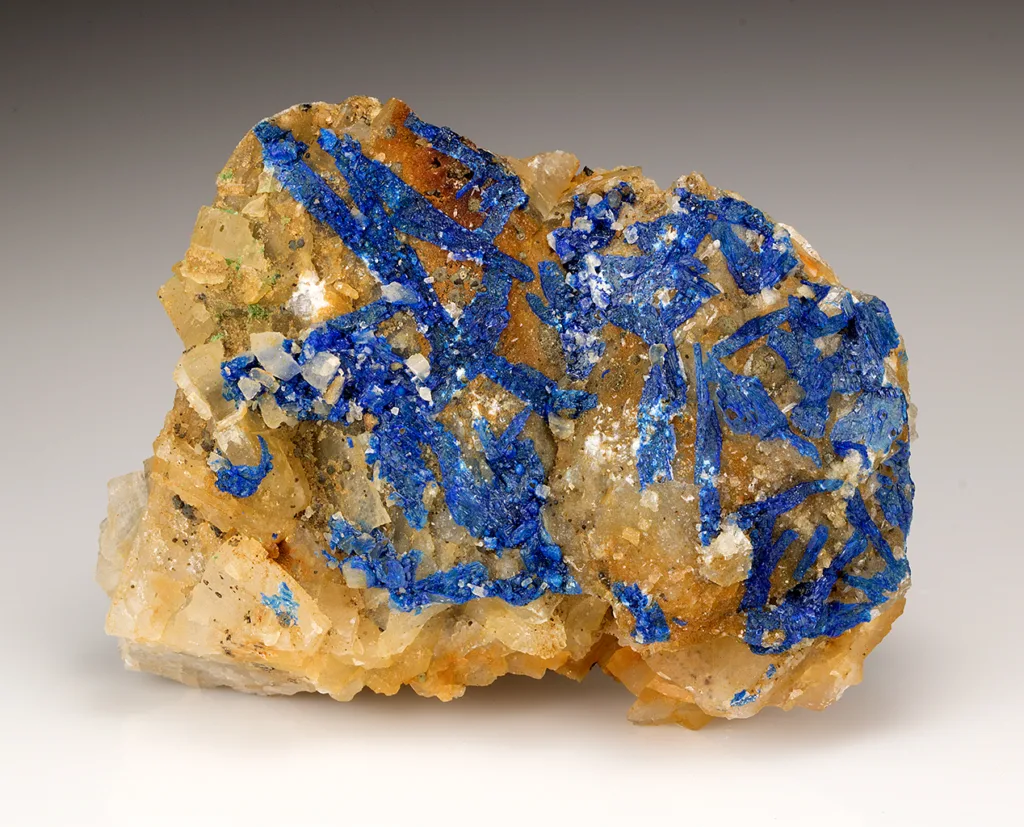
Linarite is a copper lead sulfate hydroxide mineral known for its distinctive physical, optical, and chemical properties. Here are some of the key characteristics of this mineral:
Physical Properties:
- Color: Linarite is renowned for its deep blue to azure color, which can range from sky blue to navy blue. It often exhibits a rich, vivid hue.
- Luster: The mineral typically has a vitreous to resinous luster, giving it a glassy or slightly waxy appearance.
- Transparency: Linarite crystals can be transparent to translucent. When they are transparent, they can transmit light to some extent.
- Crystal System: Linarite crystallizes in the monoclinic crystal system. It forms prismatic to tabular crystals with a variety of crystal habits.
- Cleavage: Linarite exhibits poor cleavage, meaning it does not readily break along well-defined planes.
- Fracture: The mineral often displays a subconchoidal fracture, which means it breaks with curved and irregular surfaces.
- Hardness: Linarite has a moderate hardness, typically ranging from 2.5 to 3 on the Mohs scale. This means it can be scratched by a fingernail but is harder than most minerals with similar luster.
- Density: The density of linarite is relatively high, with values typically ranging from 6.7 to 6.9 grams per cubic centimeter.
- Refractive Index: Linarite has a refractive index that varies depending on the specific sample, but it typically falls within the range of 1.700 to 1.860.
- Birefringence: Linarite is birefringent, which means it can split a light ray into two separate rays as it passes through the crystal. This property can be used for identifying the mineral.
- Dispersion: The mineral has a relatively high dispersion, which means it can create colorful spectral effects when viewed under certain lighting conditions.
Chemical Properties:
- Chemical Formula: The chemical formula of linarite is CuPb(SO4)(OH)2. It contains copper (Cu), lead (Pb), sulfate (SO4) ions, and hydroxide (OH) ions.
- Taste: Linarite has a sweet metallic taste, which is a characteristic feature of lead-containing minerals. However, it is strongly discouraged to taste minerals due to the potential toxicity of lead.
- Streak: The streak of linarite, when scratched on an unglazed porcelain plate, is usually pale blue to blue-gray, which is consistent with its copper content.
- Solubility: Linarite is sparingly soluble in water. When linarite crystals come into contact with water, they can slowly dissolve, releasing copper and lead ions into the solution.
- Associations: Linarite is commonly associated with other secondary minerals like anglesite (lead sulfate), cerussite (lead carbonate), and azurite (copper carbonate), all of which can occur in the same geological environments.
Linarite’s physical, optical, and chemical properties, along with its striking blue color, make it an interesting mineral for both mineral enthusiasts and researchers in the fields of mineralogy and geology. However, it’s important to handle linarite with care due to the presence of lead, which can be toxic if ingested or inhaled.
Identification and Characterization
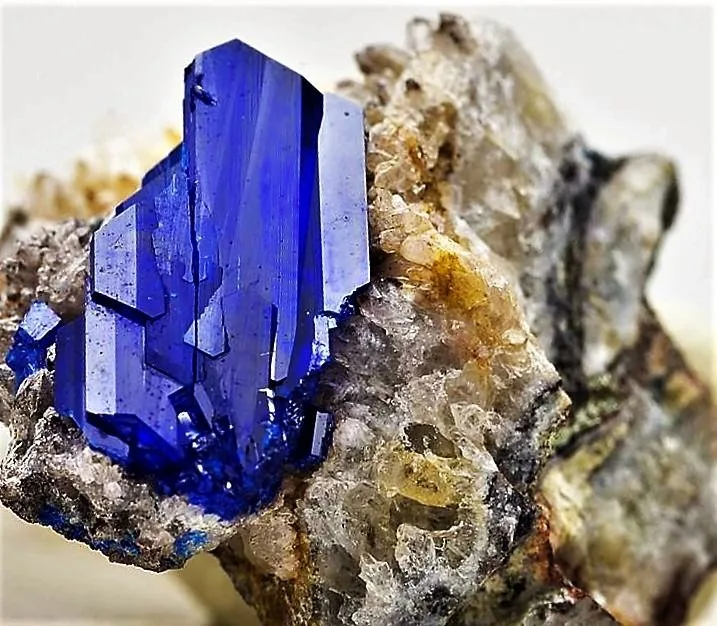
The identification and characterization of linarite involve a combination of physical, optical, and chemical tests and observations. Mineralogists and geologists use these methods to accurately identify and describe linarite samples. Here is a step-by-step guide on how linarite can be identified and characterized:
Identification:
- Color: One of the most distinctive features of linarite is its vibrant blue color. Examine the color of the mineral, which can range from light blue to deep azure.
- Luster: Observe the mineral’s luster, which is typically vitreous to resinous, giving it a glassy or slightly waxy appearance.
- Transparency: Check whether the linarite sample is transparent or translucent. Transparency can vary among different specimens.
- Crystal Form: Linarite often forms prismatic to tabular crystals. Examine the crystal structure and habit to see if it matches linarite’s monoclinic crystal system.
- Hardness: Determine the hardness of the mineral by testing it against the Mohs scale. Linarite typically has a hardness ranging from 2.5 to 3, which means it can be scratched by a fingernail but is harder than most minerals with a similar luster.
- Streak: Scratch the mineral on an unglazed porcelain plate to observe its streak. The streak is typically pale blue to blue-gray due to the presence of copper.
- Cleavage and Fracture: Examine the mineral for cleavage and fracture characteristics. Linarite usually has poor cleavage and may exhibit a subconchoidal fracture.
- Density: Measure the density of the sample using appropriate techniques and equipment. Linarite has a relatively high density, typically ranging from 6.7 to 6.9 g/cm³.
Characterization:
- Refractive Index: Use a refractometer to measure the refractive index of the linarite sample. The refractive index can vary within the range of 1.700 to 1.860.
- Birefringence: Determine whether the mineral is birefringent by observing interference colors when viewed under polarized light. Linarite is known for its birefringent properties.
- Chemical Tests: Conduct chemical tests to confirm the presence of specific elements and ions. Linarite’s chemical formula is CuPb(SO4)(OH)2, so tests for copper (Cu), lead (Pb), sulfate (SO4), and hydroxide (OH) ions can be performed. Some common chemical tests include the use of reagents to produce characteristic reactions (e.g., precipitation reactions).
- X-ray Diffraction (XRD): Perform XRD analysis to identify the mineral’s crystal structure and confirm its identity. XRD can provide detailed information about the arrangement of atoms within the mineral.
- Microscopic Examination: Examine the linarite sample under a petrographic microscope to observe its crystal structure, inclusions, and any other microscopic features that can aid in identification.
- Associations: Consider the geological context in which the linarite sample was found. Linarite is often associated with specific minerals like anglesite, cerussite, and azurite, which can provide clues to its presence.
It’s important to note that proper handling and care should be taken when working with linarite, as it contains lead, which can be toxic. Personal protective equipment should be used, and samples should be handled in a controlled environment to prevent the ingestion or inhalation of lead-containing dust or particles.
Overall, the identification and characterization of linarite involve a combination of visual, physical, optical, and chemical methods to ensure accurate and conclusive results.
Applications and Uses Areas
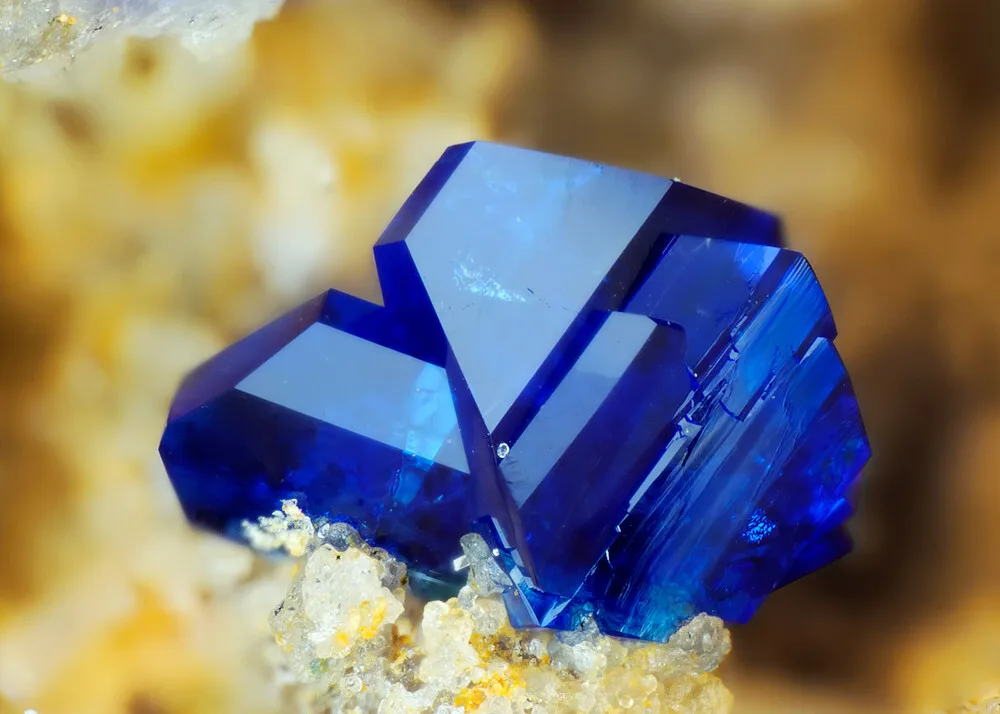
Linarite is not a mineral that is typically used for industrial or practical applications, as its primary significance lies in its geological, mineralogical, and collector appeal due to its beautiful blue color. However, there are some areas where it may have limited uses or applications:
- Mineral Collecting: Linarite is highly sought after by mineral collectors and enthusiasts due to its striking blue color and attractive crystal formations. It is a valued addition to mineral collections and can be displayed as a specimen.
- Scientific Research: Linarite, like many other minerals, plays a crucial role in scientific research related to mineralogy, geology, and crystallography. Researchers may study linarite for its crystal structure, formation processes, and its role in the development of ore deposits.
- Educational Purposes: Linarite is often used in educational settings to help students and geology enthusiasts learn about mineral identification, crystallography, and the relationship between minerals and ore deposits.
- Gem and Jewelry Industry: While not a typical gemstone, linarite’s attractive blue color could potentially be used for ornamental purposes. However, it is not commonly used in the gem and jewelry industry due to its limited availability and the presence of lead, which raises health concerns.
- Research in Ore Geology: The presence of linarite can be indicative of nearby lead and copper ore deposits. Geologists and mineral exploration companies may use linarite as a marker for prospecting in certain geological settings.
- Historical and Cultural Significance: In some cases, linarite specimens may be displayed in museums or used in historical and cultural exhibits to showcase the beauty and diversity of minerals.
It’s important to note that the main value of linarite is not in its practical applications but rather in its aesthetic and scientific appeal. Due to the presence of lead in linarite, handling it should be done with care, and safety precautions should be observed to prevent potential health risks associated with lead exposure.
Varieties and Related Minerals
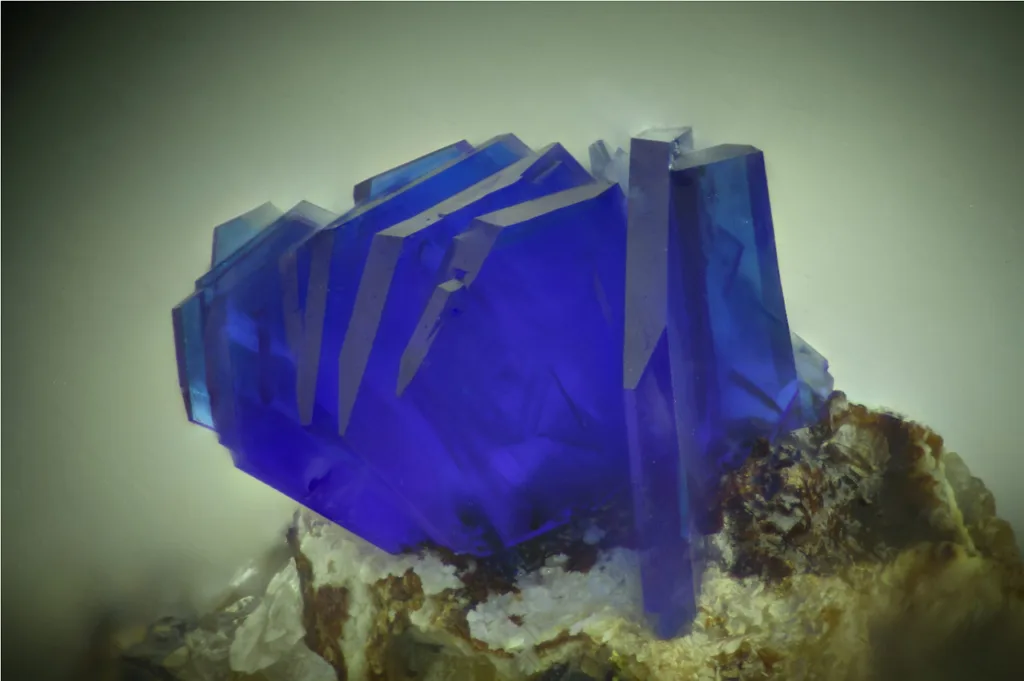
Linarite is a distinct mineral with a characteristic deep blue color, but it is part of a broader group of minerals known as the “linarite group” or “linarite supergroup.” These minerals share some structural similarities and often co-occur in geological settings. Varieties and related minerals within the linarite group include:
- Linarite: Linarite is the primary member of the linarite group and is known for its intense blue color. Its chemical formula is CuPb(SO4)(OH)2.
- Caesarite: Caesarite is a rare variety of the linarite group that is named after Julius Caesar. It is a lead copper sulfate hydroxide mineral with the chemical formula Cu2Pb3(SO4)3(OH)6. Caesarite shares some structural similarities with linarite and is also a blue mineral.
- Kettnerite: Kettnerite is another mineral within the linarite supergroup. It has the chemical formula CaBi(NO3)3(OH)(H2O)3 and is primarily composed of bismuth, calcium, and nitrate ions. Unlike linarite and caesarite, kettnerite is not blue but colorless to white or yellow.
- Leadhillite: Leadhillite is a lead sulfate carbonate mineral that is closely related to linarite. It forms as a secondary mineral in lead ore deposits, often in association with linarite. Its chemical formula is Pb4(SO4)(CO3)2(OH)2.
- Susannite: Susannite is a rare member of the linarite group and is named after Susanna von Carnall. Its chemical formula is Pb4(SO4)(CO3)2(OH)2. It is found in lead ore deposits and is closely related to leadhillite and linarite.
- Paralaurionite: Paralaurionite is a mineral that is often associated with linarite in lead ore deposits. It has the chemical formula PbCl(OH) and is a chloride hydroxide of lead. Its color is typically white, gray, or colorless.
These minerals within the linarite group share structural similarities and are often found together in geological environments where primary lead and copper ore minerals have undergone weathering and alteration. While linarite is renowned for its blue color, the other minerals in the group can have different colors and characteristics. Collectors, mineralogists, and geologists often study these minerals due to their association with ore deposits and their contribution to the understanding of geological processes.
Notable Linarite Localities of Linarite
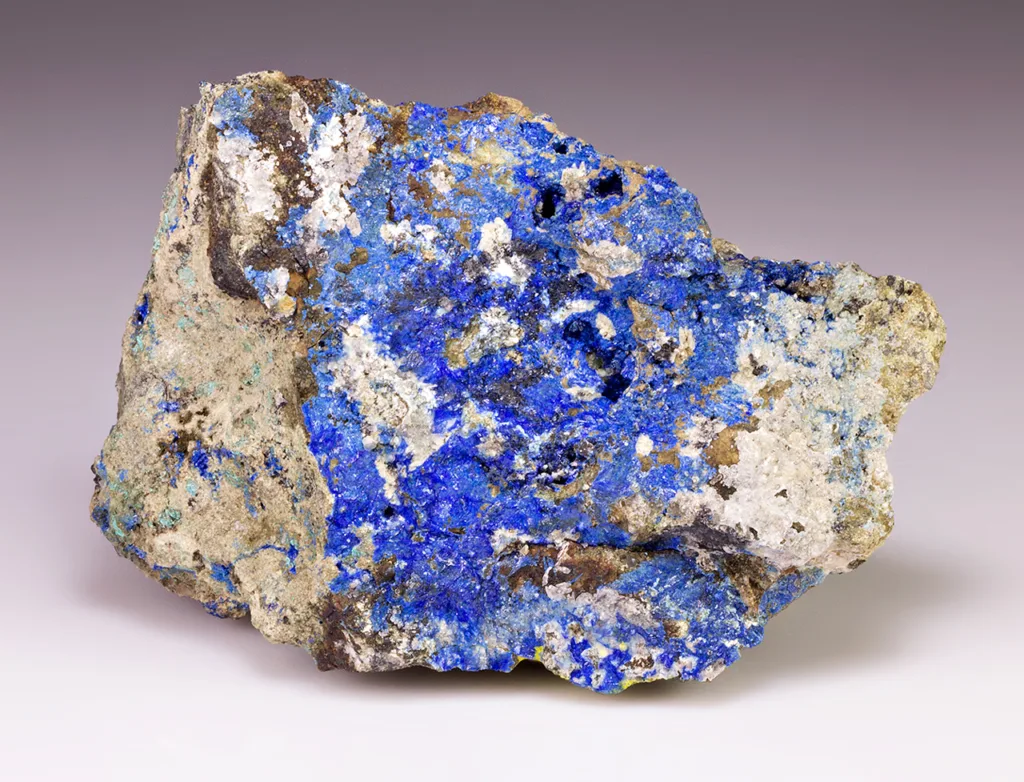
Linarite has been found in several notable localities around the world, often in association with lead and copper ore deposits. Some of the most significant localities for linarite include:
- Linares District, Spain: Linarite was first discovered in the Linares district in Spain, from which it derives its name. This region in the province of Jaén is renowned for its lead and zinc deposits, and linarite is one of the key secondary minerals associated with these ore bodies. The Linares district has yielded some of the finest linarite specimens.
- Broken Hill, New South Wales, Australia: Broken Hill is a famous mining district in Australia known for its rich lead-zinc-silver ore deposits. Linarite is found in the oxidized zones of these deposits and has been collected by mineral enthusiasts for decades.
- Tsumeb Mine, Namibia: The Tsumeb Mine is celebrated for its world-class mineral specimens, and linarite has been discovered there in association with other secondary minerals. The mine has produced exceptional and often large linarite crystals.
- Blanchard Mine, New Mexico, USA: The Blanchard Mine in the Hansonburg mining district of New Mexico is a well-known locality for linarite. The mineral can be found in this region along with other secondary minerals in lead-zinc deposits.
- Kabwe Mine (Broken Hill Mine), Zambia: The Kabwe Mine, formerly known as the Broken Hill Mine, is one of the world’s oldest lead and zinc mines. It has produced a variety of secondary minerals, including linarite.
- Bristol, Connecticut, USA: The locality in Bristol, Connecticut, has produced fine linarite specimens in association with lead and copper ore deposits. These specimens are often sought after by collectors.
- Red Cloud Mine, Arizona, USA: The Red Cloud Mine in Arizona is famous for its colorful and diverse mineral specimens. Linarite, along with other minerals, has been found in this mine.
- M’Fouati Mine, Republic of the Congo: The M’Fouati Mine in Central Africa has been a source of linarite specimens. This mine is known for its lead and zinc mineralization.
- M’fouati District, Republic of the Congo: In addition to the M’Fouati Mine, linarite has also been found in the broader M’fouati District in the Republic of the Congo.
These localities are important for mineral collectors and researchers due to the presence of linarite in various geological contexts. The mineral specimens from these areas often exhibit rich blue colors and well-formed crystals, making them highly desirable to collectors and enthusiasts.




































